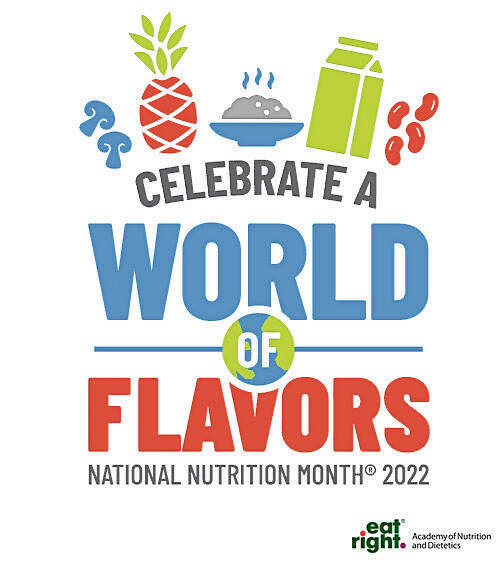
Marshall

Shamrock Shake Smoothie
Submitted photo

Colcannon Potatoes
Submitted photo

March is National Nutrition Month, an annual campaign created by the Academy of Nutrition and Dietetics.
Submitted photo
National Nutrition Month is an annual campaign created by the Academy of Nutrition and Dietetics.
During the month of March, people are invited to learn about making informed food choices and developing healthy eating and physical activity habits.
Celebrating flavors from other cultures is one way to nourish our bodies and appreciate our diversity. Everyone is unique with different goals, backgrounds and tastes. Seeing a registered dietitian nutritionist can help people learn how to create healthy habits that celebrate their heritage and introduce them to new foods and flavors.
March 17 is St. Patrick’s Day, which leads to an opportunity of making Irish recipes with a healthy twist.
Molly Marshall, health and human services educator for Purdue Extension Jackson County, said eatingwell.com is a good website for recipes, including Irish dishes such as slow-cooker Irish sausage, bean and cabbage stew, shamrock shake smoothie and red potato colcannon.
Meal planning
National Nutrition Month is about making good choices, and Marshall said planning meals ahead of time is a good place to start and is beneficial in several ways.
She said it can save time and money and decrease stress levels because it’s answering the question “What’s for dinner?”
“I kind of look at it as taking an approach to meal planning and if you want to plan on a weekly basis,” Marshall said. “Some people plan for a week at a time, and then there are some who think a little further out and plan for a month at a time.”
For beginners in meal planning, she suggests taking it slow and maybe start planning for three days at a time. Then once you get the hang of it, work your way up to a week at a time
“The next step is to look at your schedule and see what you have going on in the course of the day and evening and deciding when you actually have time to cook meals,” she said. “It’s an important thing to consider, so if you have a meeting two nights during the week, those might be good nights for leftovers.”
Marshall said she likes the idea of cooking once and eating twice, meaning she makes a meal and cooks enough so there are leftovers to use that week or to put in the freezer.
“Find 10, 20 or 30 entrees that your family likes, make a list of them and then you’ll have your list when you go to do your meal planning,” she said. “Start there and add new meals to the list as you try out new recipes.”
Marshall said by having a plan in place, you’ve already done your grocery shopping for your meals, which saves you from those last-minute trips to the grocery store.
“You’re more likely to buy the temptation items that you don’t normally buy when you go to the store at 5 o’clock and you’re hungry, which can cost you extra money,” she said.
Remember to look at supermarket ads so you can plan your meals based on what’s on sale, which is a good way to save some dollars, Marshall said.
“Also, keep a running grocery list on your phone, in an app or on a piece of paper so if you run out of something or need a few things, just write it down,” she said. “Think about the foods you typically eat and normally have in your freezer and your pantry and ask input from your family members and see what food they’d like, and that way, everybody’s happy.”
Try to use fresh ingredients first, and help cut down on food waste by putting fresh foods and items with the earliest expiration dates in the front of your refrigerator, which Marshall calls “first in, first out.”
Tips for eating healthy at restaurants
If you have the ingredients to cook at home, you won’t have to go out to eat because eating out can cost more than eating at home.
There will still be occasions, however, to eat out at a restaurant, and in those cases, it’s good to plan ahead.
“Think ahead and plan where you’re going to go eat, and if you know you’re going to be eating out for dinner, then have a lighter breakfast and lunch,” Marshall said. “Read the menu and look for items that are baked, broiled, grilled, poached, steamed and roasted.”
Eat fats just occasionally and in smaller portions. Usually, they will be in menu items as fried, buttered, breaded and with cream.
“If you know you’re going to order something like that, plan ahead and maybe split the meal or take half home and eat leftovers for another meal,” Marshall said. “It’s important to watch the portion size when going out to eat, like the plates for customers at buffets is more the right size.”
She said it’s hard to overfill a smaller plate, and even an 11- to 12-inch dinner plate is too big, and you can trick your brain by filling up a smaller plate because it looks like you’re getting a lot of food.
“Also, you can choose an appetizer as an entrée because sometimes, those portions are a little smaller,” Marshall said. “Then another good idea is getting a soup or salad first, and that way, you’re getting your veggies in at the beginning, then have a lighter course after that.”
She recommends for side dishes, opt for a baked potato or side salad instead of fries, and when ordering a salad, get dressing on the side so you can control how much goes on your food.
The U.S. Department of Agriculture develops and promotes dietary guidance and nutritional recommendations aimed at improving health and well-being.
Marshall said those guidelines have changed slightly throughout the years.
“It started out with the four food groups in the 1950s all the way to the 1970s, and then they added a couple more groups,” she said. “The food guide pyramid came out in 1992 with recommended food groups and servings per day. Then in 2005, it was updated by adding a person climbing steps to indicate physical activity, which was good.”
The MyPlate model, which is the current recommendation, was introduced in 2011.
“What I like about MyPlate is it’s a great visual cue and shows you the food groups on a plate and the portion size recommended for each,” Marshall said. “The easy part is half your the plate should be fruits and vegetables, and it’s a good visual that helps remind us to eat healthy.”
Information about USDA food guidelines can be found at myplate.gov, and ideas on how to celebrate National Nutrition Month can be found at eatright.org.
